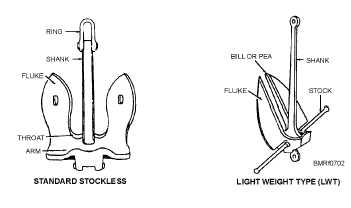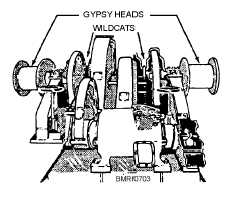can be readily disassembled whenever it is desirable to
break the chain.
STOWING CHAIN
As the chain comes aboard, it passes along the deck
on metal flash plates, over the wildcat, and down into
the chain locker. Each chain goes into a bin called a
chain locker, as shown in figure 7-1. Its bitter end is
secured to a ring bolt on the bulkhead of the chain
locker.
ANCHOR WINDLASSES
The Navy uses two types of anchor windlasses for
lifting the ship’s anchor—the vertical shaft type and the
horizontal shaft type (fig. 7-3). The vertical shaft type is
used on most combatant ships. The horizontal shaft type
is used on amphibious and auxiliary ships. Both types
are equipped with wildcats, which engage the links of
the anchor chain. The wildcat may be disengaged when
it is desired to use the capstan (vertical type) or the
gypsy heads (horizontal type) for handling lines or wire.
ACCOMMODATION LADDER
F r e q u e n t l y, t h e a c c o m m o d a t i o n l a d d e r i s
mistakenly called the gangway. However, gangway
actually means the opening in a bulwark or life rail that
gives access to a brow or an accommodation ladder. An
accommodation ladder (fig. 7-4) consists essentially of
an upper and a lower platform connected by a ladder.
The lower end is supported, raised, and lowered by a
block and tackle (called falls) and is usually suspended
from a davit.
Brow is the Navy term for gangplank. Brows are
ramps used between ships and between a ship and pier.
They may be simply two or three wooden planks
fastened together, or they may be elaborate affairs with
handrails and wheels at one or both ends to prevent a
ship’s motion from unduly affecting the positioning of
the brow.
MOORING LINES
A ship is moored when it’s made fast to a buoy,
when it’s between two buoys, when it’s between two
anchors, or when it’s secured by lines alongside a pier or
another ship.
The lines used in mooring a ship alongside a pier are
shown in figure 7-5. Well in advance of mooring, the
lines should be faked down, fore and aft, each near the
chock through which it passes in preparation for passing
the line. You will learn about the procedure for faking a
7-3
Student Notes:
Figure 7-2.—Anchors.
Figure 7-3.—Horizontal shaft anchor windlass.





